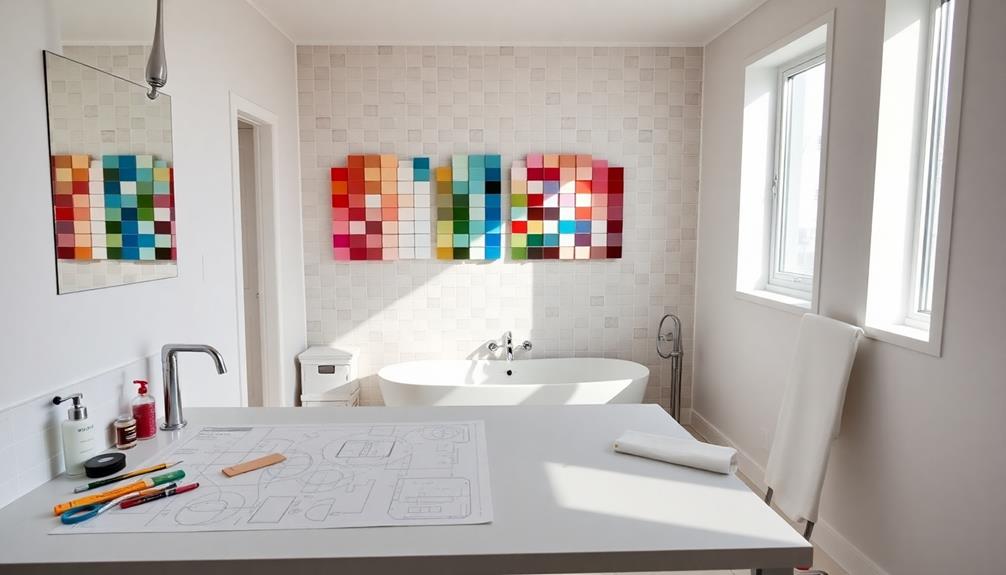To start planning your bathroom renovation project, begin by determining the extent of the work. Decide if you want to simply refresh the surfaces or completely renovate the space. Then, set a budget that covers materials, labor, and any unforeseen expenses. You will need to decide whether to tackle the project yourself or hire a professional contractor to ensure quality work and compliance with building codes. Create a detailed timeline for demolition, plumbing work, and installation, and make sure to obtain any necessary permits. Lastly, consider adding finishing touches such as moisture-resistant paint and durable flooring. By following these steps, you will be on your way to a successful renovation project, and there are more tips to explore for maximizing your project! For added convenience, think about incorporating a smart thermostat and touchless faucets. These small additions can greatly enhance the functionality of your bathroom. Need more bathroom renovation ideas? Explore energy-efficient lighting options and environmentally-friendly fixtures to update your space while reducing your carbon footprint. Additionally, look into different storage solutions to optimize space and keep your bathroom neat and organized.
Key Takeaways
- Define the scope of your remodel, choosing between a surface refresh or a complete gut and replace for a full update.
- Establish a comprehensive budget that includes materials, contractor fees, and a buffer for unexpected expenses.
- Assess your DIY skills versus hiring a contractor to ensure compliance with building codes and quality work.
- Create a detailed project timeline that outlines essential tasks like demolition, plumbing, and installation.
- Choose durable and moisture-resistant materials for fixtures, flooring, and finishes to enhance both functionality and design.
Determine Remodel Level
When planning your bathroom remodel, the first step is determining the remodel level that best suits your needs and budget.
You'll want to clearly define the scope of your project. If you're looking for a quick refresh, a surface remodel might be ideal. This involves cosmetic updates like painting, replacing fixtures, and installing new flooring with minimal disruption and costs in the low thousands.
Additionally, consider the importance of innovative design and functionality in your remodel to enhance the overall experience.
If you prefer to keep the existing layout but replace everything, you might opt for a gut and replace approach. This can range from $15,000 to $30,000, depending on your material choices.
However, if you're considering moving fixtures around, be prepared for plumbing changes that can complicate your project timeline and increase costs.
For those wanting a complete redesign, which may involve structural changes, expect costs to exceed $30,000.
This extensive remodel requires careful planning and answers to some critical planning questions.
Budgeting and Financing

After determining the remodel level that suits your needs, the next step is to establish a solid budget and financing plan.
Start by creating a thorough remodeling budget that includes all potential costs. Remember, bathroom remodels can range from a few thousand dollars to $15,000-$30,000 or more, so careful financial planning is essential.
It's also important to take into account your overall budget management skills to guarantee you stay within your financial limits.
Reflect on the following when budgeting:
- Materials: Choose quality options that fit your style and budget.
- Contractor Fees: Factor in the costs of hiring professionals versus DIY.
- Unexpected Expenses: Set aside a portion of your budget for any surprises.
Explore financing options like home equity loans or grants for home improvements to help manage larger projects.
It's wise to identify areas where you can splurge versus save. For instance, invest in durable flooring while opting for budget-friendly fixtures.
DIY or Hire a Contractor

Deciding whether to tackle your bathroom remodel as a DIY project or hire a contractor is a crucial step in the planning process. Start by evaluating your skill level and experience. While surface alterations might be manageable for you, complex tasks like plumbing work or tiled showers often require professional expertise.
Additionally, just as the value of home security systems can provide peace of mind, hiring a contractor can offer reassurance that the project will be completed correctly and efficiently.
Hiring a contractor not only guarantees compliance with local building codes but also provides quality assurance, especially for intricate projects. Consider the time investment too; DIY projects can take longer than you expect, while a contractor can expedite the completion of your remodel.
Think about the long-term financial impact as well. Although DIY may save on labor costs upfront, hiring professionals can enhance the overall quality and longevity of your remodel, potentially increasing your home's value.
Remember to explore financing options if you choose to hire a contractor, as professional renovations can exceed $15,000 for mid-level work and over $30,000 for extensive projects.
Ultimately, weigh your budget against your skills and the complexity of the work required to make the best decision for your bathroom remodel.
Planning and Execution Steps

Once you've settled on whether to go DIY or hire a contractor, the next step is to outline your planning and execution strategy.
Start by evaluating your current bathroom layout and deciding if changes are necessary based on your storage needs and fixture preferences. Consider how energy-efficient appliances can enhance your bathroom remodel, especially if you're incorporating smart home features.
Next, create a detailed project timeline that prioritizes tasks like demolition, plumbing, and installation. Confirm it aligns with the expected delivery dates for materials.
Here's a checklist to guide you:
- Identify necessary permits to comply with local building codes.
- Consult with contractors for accurate quotes on plumbing and electrical work.
- Develop a list of essential materials and services for the remodel.
Lastly, maintain clear communication with your contractors throughout the project. This confirms you can quickly address any unexpected issues and stay aligned with your design vision.
Installation and Finishing Touches

The installation phase of your bathroom remodel is vital for ensuring a seamless finish. Start by completing major installations, like plumbing fixtures and cabinetry, to create a solid foundation for the rest of the project.
Once those are in place, you can focus on applying moisture-resistant paint with a satin or semi-gloss finish. This not only enhances durability but also makes for easy cleaning. Incorporating an enchanting narrative into your design can help you visualize how each element will function in the space, ensuring a cohesive look and feel mood boards essential.
Next, choose flooring materials that balance aesthetics and functionality. Options like ceramic tile or luxury vinyl provide water resistance and slip resistance, essential in a bathroom setting.
After the flooring, pay attention to trim and moldings; select high-quality materials that complement your overall design vision while adding an elegant touch.
Frequently Asked Questions
What Is the Correct Order to Remodel a Bathroom?
To remodel your bathroom correctly, start with demolition, then tackle framing, plumbing, and electrical work. Next, install fixtures and finishes before addressing cosmetic details. Finally, conduct a thorough inspection to verify everything's up to standard.
Where Do I Start When Planning a Bathroom Renovation?
Think of your bathroom as a blank canvas waiting for your brush. Start by evaluating the layout and pinpointing pain points. Gather inspiration, consult a contractor, and create a budget to guide your renovation journey.
How Do I Start a Bathroom Project?
To start your bathroom project, assess your current layout, list desired changes, gather inspiration from design platforms, consult a contractor for feasibility, and create a budget and timeline to guide your renovation process.
What Is the Most Expensive Part of a Bathroom Remodel?
The most expensive part of a bathroom remodel is often labor costs, which can consume up to 35% of your budget. High-end fixtures and unexpected repairs can also greatly increase your overall expenses.
Conclusion
As you wrap up your bathroom remodeling project, remember that every small detail adds to the bigger picture. Whether you're going all out or just making a few tweaks, your space should reflect your style and needs. Embrace the journey, and don't hesitate to seek help if needed; after all, even the best artists need a little guidance. With careful planning and execution, you'll transform your bathroom into a personal oasis that you'll love for years to come.









